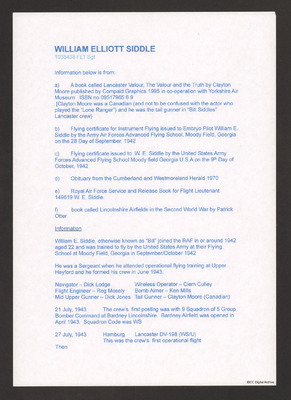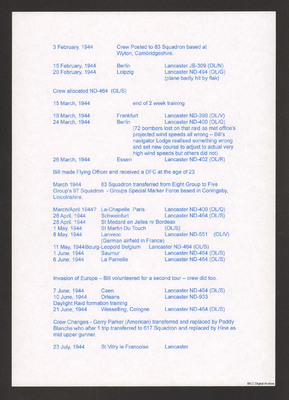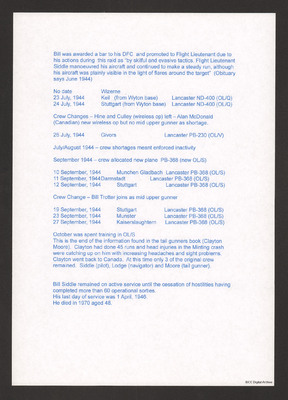William Elliot Siddle
Title
William Elliot Siddle
Description
Bill Siddle's time in the RAF pieced together by research. He was a pilot who flew the Lancaster with 9 and 83 Squadrons. He was commissioned in 1944, was awarded the DFC and Bar and completed more than 60 operations. He left the service in 1946 and died in 1970.
Temporal Coverage
Spatial Coverage
Language
Format
Four typewritten pages
Conforms To
Publisher
Rights
This content is available under a CC BY-NC 4.0 International license (Creative Commons Attribution-NonCommercial 4.0). It has been published ‘as is’ and may contain inaccuracies or culturally inappropriate references that do not necessarily reflect the official policy or position of the University of Lincoln or the International Bomber Command Centre. For more information, visit https://creativecommons.org/licenses/by-nc/4.0/ and https://ibccdigitalarchive.lincoln.ac.uk/omeka/legal.
Contributor
Identifier
MSiddleWE1038438-151208-030001, MSiddleWE1038438-151208-030002, MSiddleWE1038438-151208-030003, MSiddleWE1038438-151208-030004
Transcription
WILLIAM ELLIOTT SIDDLE
1038438 FLT Sgt
Information below is from:
a) A book called Lancaster Valour, The Valour and the Truth by Clayton Moore published by Compaid Graphics 1995 in co-operation with Yorkshire Air Museum ISBN no 09517965 6 9
[Clayton Moore was a Canadian (and not to be confused with the actor who played the “Lone Ranger”) and he was the tail gunner in “Bill Siddles” Lancaster crew}
b) Flying certificate for Instrument Flying issued to Embryo Pilot William E. Siddle by the Army Air Forces Advanced Flying School, Moody Field, Georgia on the 28 Day of September, 1942
c) Flying certificate issued to W.E Siddle by the United States Army Forces Advanced Flying School Moody field Georgia U.S.A on the 9th Day of October, 1942
d) Obituary from the Cumberland and Westmoreland Herald 1970
e) Royal Air Force Service and Release Book for Flight Lieutenant 149619 W.E. Siddle.
f) book called Lincolnshire Airfields in the Second World War by Patrick Otter
[underlined] Information [/underlined]
William E. Siddle, otherwise known as “Bill” joined the RAF in or around 1942 aged 22 and was trained to fly by the United States Army at their Flying School at Moody Field, Georgia in September/October 1942
He was a Sergeant when he attended operational flying training at Upper Heyford and he formed his crew in June 1943.
Navigator- Dick Lodge
Flight Engineer- Reg Mosely
Mid Upper Gunner- Dick Jones
Wireless Operator- Clem Culley
Bomb Aimer- Ken Mills
Tail Gunner- Clayton Moore (Canadian)
21 July, 1943 The crew’s first posting was with 9 Squadron of 5 Group Bomber Command at Bardney Lincolnshire. Bardney Airfield was opened in April 1943. Squadron Code was WS
27 July, 1943 Hamburg Lancaster DV-198 (WS/U) This was the crew’s first operational flight Then
[page break]
28 July, 1943 Hamburg Lancaster ED-666 (WS/G)
2 August, 1943 Hamburg Lancaster ED-654 (WS/W)
9 August, 1943 Mannheim Lancaster DV-198 (WS/U)
27 August, 1943 Nurenburg Lancaster ED-975 (WS/Y)
30 August, 1943 Munchen Gladbach Lancaster ED-975 (WS/Y)
5 September, 1943 Mannheim Lancaster ED-975 (WS/Y)
6 September, 1943 Munich Lancaster ED-975 (WS/Y)
On this Munich trip the plane was badly hit by flak. Bill was given priority landing as they were losing fuel and they nearly made it back to Bardney but Bill had to put the plane down in a field in Minting as all engines failed. Everyone survived although Bill lost teeth from being flung through the windscreen; Mosely, Hill and Jones had back injuries; Lodge broke his arm getting off the downed plane. Moore was found still in his rear turret under a hedge and he suffered concussion. There is a picture of the crashed ED-975 in Moore’s book.
26 September, 1943 new crew with Jock Wilson, Mick Machin and Gerry Parker (American) replacing Mosely, Hill and Jones respectively took ED-499 (WS/X) on a night flying test. Bill found he could not land and took 9 attempts. Bill then kicked everyone else out expect the flight engineer and after checking the landing gear went straight back up and made a number of landings to get his nerve back. Bill only got a telling off.
22 October, 1943 Kassell Lancaster CV-340 (WS/Q)
2 November, 1943 Crew allocated “Spirit of Russia” Lancaster EE-136 (WS/R)
10 November, 1943 Modane Lancaster EE-136 (WS/R) short on fuel Bill landed in Cambridgeshire and the field forgot to tell Bardney and so all reported missing!
General shortages of crews and crew members stopped Bill and his crew flying together. Jones (who had returned to the crew after recovering from the Minting crash) flew 2 Dec as spare mid upper gunner with WS/C and did not return/shot down. Parker, the American was then made the permanent mid upper gunner. Lodge the Navigator returned to the crew 20 December, 1943.
23 December, 1943 Berlin EE-136
29 December, 1943 Berlin EE-136
5 January, 1944 Stettin EE-136
January, 1944 Braunschweig EE-136
Entire Crew applied to join the Pathfinders
Crew went to PFF Navigation Training Unit at RAF Station Upwood, Cambs
[page break]
3 February, 1944 Crew Posted to 83 Squadron based at Wyton, Cambridgeshire.
15 February, 1944 Berlin Lancaster JB-309 (OL/N)
20 February, 1944 Leipzig Lancaster ND-494 (OL/G) (plane badly hit by flak)
Crew allocated ND-464 (OL/S)
15 March, 1944 end of 2 week training
18 March, 1944 Frankfurt Lancaster ND-390 (OL/V)
24 March, 1944 Berlin Lancaster ND-400 (OL/Q) (72 bombers lost on that raid as met office’s projected wind speeds all wrong- Bill’s navigator Lodge realised something wrong and set new course to adjust to actual very high wind speeds but others did not)
26 March, 1944 Essen Lancaster ND-402 (OL/R)
Bill made Flying Officer and received a DFC at the age of 23
March 1944 83 Squadron transferred from Eight Group to Five
Group’s 97 Squadron- Groups Special Marker Force based in Coningsby, Lincolnshire
March/April 1944? La-Chapelle Paris Lancaster ND-400 (OL/Q)
26 April, 1944 Schweinfurt Lancaster ND-464 (OL/S)
28 April, 1944 St Medard en Jalles nr Bordeax
1 May, 1944 St Martin Du Touch (OL/S)
8 May, 1944 Lanveoc Lancaster ND-551 (OL/V) (German airfield in France)
11 May, 1944 Bourg-Leopold Belgium Lancaster ND-464 (OL/S)
1 June, 1944 Saumur Lancaster ND-464 (OL/S)
6 June, 1944 La Parnelle Lancaster ND-464 (OL/S)
Invasion of Europe- Bill volunteered for a second tour- crew did too.
7 June, 1944 Caen Lancaster ND-464 (OL/S)
10 June, 1944 Orleans Lancaster ND-933
Daylight Raid formation training
21 June, 1944 Wesselling, Cologne Lancaster ND-464 (OL/S)
Crew Changes- Gerry Parker (American) transferred and replaced by Paddy Blanche who after 1 trip transferred to 617 Squadron and replaced by Hine as mid upper gunner.
23 July, 1944 St Vitry le Francoise Lancaster
[page break]
Bill was awarded a bar to his DFC and promoted to Flight Lieutenant due to his actions during this raid as “by skilful and evasive tactics, Flight Lieutenant Siddle manoeuvred his aircraft and continued to make a steady run, although his aircraft was plainly visible in the light of flares around the target” (Obituary says June 1944)
No date Wizerne
23 July, 1944 Keil (from Wyton base) Lancaster ND-400 (OL/Q)
24 July, 1944 Stuttgart (from Wyton base) Lancaster ND-400 (OL/Q)
Crew changes- Hine and Culley (wireless op) left- Alan McDonald (Canadian) new wireless op but no mid upper gunner as shortage.
26 July, 1944 Givors Lancaster PB-230 (OL/V)
July/August 1944- crew shortages meant enforced inactivity
September 1944- crew allocated new plane PB-368 (new OL/S)
10 September, 1944 Munchen Gladbach Lancaster PB-368 (OL/S)
11 September, 1944 Darmstadt Lancaster PB-368 (OL/S)
12 September, 1944 Stuttgart Lancaster PB-368 (OL/S)
Crew Change- Bill Trotter joins as mid upper gunner
19 September, 1944 Stuttgart Lancaster PB-368 (OL/S)
23 September, 1944 Munster Lancaster PB-368 (OL/S)
27 September, 1944 Kaiserslaughtern Lancaster PB-368 (OL/S)
October was spent training in OL/S
This is the end of the information found in the tail gunners book (Clayton Moore). Clayton had done 45 runs and head injuries in the Minting crash were catching up on him with increasing headaches and sight problems. Clayton went back to Canada. At this time only 3 of the original crew remained. Siddle (pilot), Lodge (navigator) and Moore (tail gunner).
Bill Siddle remained on active service until the cessation of hostilities having completed more than 60 operational sorties.
His last day of service was 1 April, 1946.
He died in 1970 aged 48.
1038438 FLT Sgt
Information below is from:
a) A book called Lancaster Valour, The Valour and the Truth by Clayton Moore published by Compaid Graphics 1995 in co-operation with Yorkshire Air Museum ISBN no 09517965 6 9
[Clayton Moore was a Canadian (and not to be confused with the actor who played the “Lone Ranger”) and he was the tail gunner in “Bill Siddles” Lancaster crew}
b) Flying certificate for Instrument Flying issued to Embryo Pilot William E. Siddle by the Army Air Forces Advanced Flying School, Moody Field, Georgia on the 28 Day of September, 1942
c) Flying certificate issued to W.E Siddle by the United States Army Forces Advanced Flying School Moody field Georgia U.S.A on the 9th Day of October, 1942
d) Obituary from the Cumberland and Westmoreland Herald 1970
e) Royal Air Force Service and Release Book for Flight Lieutenant 149619 W.E. Siddle.
f) book called Lincolnshire Airfields in the Second World War by Patrick Otter
[underlined] Information [/underlined]
William E. Siddle, otherwise known as “Bill” joined the RAF in or around 1942 aged 22 and was trained to fly by the United States Army at their Flying School at Moody Field, Georgia in September/October 1942
He was a Sergeant when he attended operational flying training at Upper Heyford and he formed his crew in June 1943.
Navigator- Dick Lodge
Flight Engineer- Reg Mosely
Mid Upper Gunner- Dick Jones
Wireless Operator- Clem Culley
Bomb Aimer- Ken Mills
Tail Gunner- Clayton Moore (Canadian)
21 July, 1943 The crew’s first posting was with 9 Squadron of 5 Group Bomber Command at Bardney Lincolnshire. Bardney Airfield was opened in April 1943. Squadron Code was WS
27 July, 1943 Hamburg Lancaster DV-198 (WS/U) This was the crew’s first operational flight Then
[page break]
28 July, 1943 Hamburg Lancaster ED-666 (WS/G)
2 August, 1943 Hamburg Lancaster ED-654 (WS/W)
9 August, 1943 Mannheim Lancaster DV-198 (WS/U)
27 August, 1943 Nurenburg Lancaster ED-975 (WS/Y)
30 August, 1943 Munchen Gladbach Lancaster ED-975 (WS/Y)
5 September, 1943 Mannheim Lancaster ED-975 (WS/Y)
6 September, 1943 Munich Lancaster ED-975 (WS/Y)
On this Munich trip the plane was badly hit by flak. Bill was given priority landing as they were losing fuel and they nearly made it back to Bardney but Bill had to put the plane down in a field in Minting as all engines failed. Everyone survived although Bill lost teeth from being flung through the windscreen; Mosely, Hill and Jones had back injuries; Lodge broke his arm getting off the downed plane. Moore was found still in his rear turret under a hedge and he suffered concussion. There is a picture of the crashed ED-975 in Moore’s book.
26 September, 1943 new crew with Jock Wilson, Mick Machin and Gerry Parker (American) replacing Mosely, Hill and Jones respectively took ED-499 (WS/X) on a night flying test. Bill found he could not land and took 9 attempts. Bill then kicked everyone else out expect the flight engineer and after checking the landing gear went straight back up and made a number of landings to get his nerve back. Bill only got a telling off.
22 October, 1943 Kassell Lancaster CV-340 (WS/Q)
2 November, 1943 Crew allocated “Spirit of Russia” Lancaster EE-136 (WS/R)
10 November, 1943 Modane Lancaster EE-136 (WS/R) short on fuel Bill landed in Cambridgeshire and the field forgot to tell Bardney and so all reported missing!
General shortages of crews and crew members stopped Bill and his crew flying together. Jones (who had returned to the crew after recovering from the Minting crash) flew 2 Dec as spare mid upper gunner with WS/C and did not return/shot down. Parker, the American was then made the permanent mid upper gunner. Lodge the Navigator returned to the crew 20 December, 1943.
23 December, 1943 Berlin EE-136
29 December, 1943 Berlin EE-136
5 January, 1944 Stettin EE-136
January, 1944 Braunschweig EE-136
Entire Crew applied to join the Pathfinders
Crew went to PFF Navigation Training Unit at RAF Station Upwood, Cambs
[page break]
3 February, 1944 Crew Posted to 83 Squadron based at Wyton, Cambridgeshire.
15 February, 1944 Berlin Lancaster JB-309 (OL/N)
20 February, 1944 Leipzig Lancaster ND-494 (OL/G) (plane badly hit by flak)
Crew allocated ND-464 (OL/S)
15 March, 1944 end of 2 week training
18 March, 1944 Frankfurt Lancaster ND-390 (OL/V)
24 March, 1944 Berlin Lancaster ND-400 (OL/Q) (72 bombers lost on that raid as met office’s projected wind speeds all wrong- Bill’s navigator Lodge realised something wrong and set new course to adjust to actual very high wind speeds but others did not)
26 March, 1944 Essen Lancaster ND-402 (OL/R)
Bill made Flying Officer and received a DFC at the age of 23
March 1944 83 Squadron transferred from Eight Group to Five
Group’s 97 Squadron- Groups Special Marker Force based in Coningsby, Lincolnshire
March/April 1944? La-Chapelle Paris Lancaster ND-400 (OL/Q)
26 April, 1944 Schweinfurt Lancaster ND-464 (OL/S)
28 April, 1944 St Medard en Jalles nr Bordeax
1 May, 1944 St Martin Du Touch (OL/S)
8 May, 1944 Lanveoc Lancaster ND-551 (OL/V) (German airfield in France)
11 May, 1944 Bourg-Leopold Belgium Lancaster ND-464 (OL/S)
1 June, 1944 Saumur Lancaster ND-464 (OL/S)
6 June, 1944 La Parnelle Lancaster ND-464 (OL/S)
Invasion of Europe- Bill volunteered for a second tour- crew did too.
7 June, 1944 Caen Lancaster ND-464 (OL/S)
10 June, 1944 Orleans Lancaster ND-933
Daylight Raid formation training
21 June, 1944 Wesselling, Cologne Lancaster ND-464 (OL/S)
Crew Changes- Gerry Parker (American) transferred and replaced by Paddy Blanche who after 1 trip transferred to 617 Squadron and replaced by Hine as mid upper gunner.
23 July, 1944 St Vitry le Francoise Lancaster
[page break]
Bill was awarded a bar to his DFC and promoted to Flight Lieutenant due to his actions during this raid as “by skilful and evasive tactics, Flight Lieutenant Siddle manoeuvred his aircraft and continued to make a steady run, although his aircraft was plainly visible in the light of flares around the target” (Obituary says June 1944)
No date Wizerne
23 July, 1944 Keil (from Wyton base) Lancaster ND-400 (OL/Q)
24 July, 1944 Stuttgart (from Wyton base) Lancaster ND-400 (OL/Q)
Crew changes- Hine and Culley (wireless op) left- Alan McDonald (Canadian) new wireless op but no mid upper gunner as shortage.
26 July, 1944 Givors Lancaster PB-230 (OL/V)
July/August 1944- crew shortages meant enforced inactivity
September 1944- crew allocated new plane PB-368 (new OL/S)
10 September, 1944 Munchen Gladbach Lancaster PB-368 (OL/S)
11 September, 1944 Darmstadt Lancaster PB-368 (OL/S)
12 September, 1944 Stuttgart Lancaster PB-368 (OL/S)
Crew Change- Bill Trotter joins as mid upper gunner
19 September, 1944 Stuttgart Lancaster PB-368 (OL/S)
23 September, 1944 Munster Lancaster PB-368 (OL/S)
27 September, 1944 Kaiserslaughtern Lancaster PB-368 (OL/S)
October was spent training in OL/S
This is the end of the information found in the tail gunners book (Clayton Moore). Clayton had done 45 runs and head injuries in the Minting crash were catching up on him with increasing headaches and sight problems. Clayton went back to Canada. At this time only 3 of the original crew remained. Siddle (pilot), Lodge (navigator) and Moore (tail gunner).
Bill Siddle remained on active service until the cessation of hostilities having completed more than 60 operational sorties.
His last day of service was 1 April, 1946.
He died in 1970 aged 48.
Collection
Citation
“William Elliot Siddle,” IBCC Digital Archive, accessed October 29, 2024, https://ibccdigitalarchive.lincoln.ac.uk/omeka/collections/document/44270.
Item Relations
This item has no relations.




